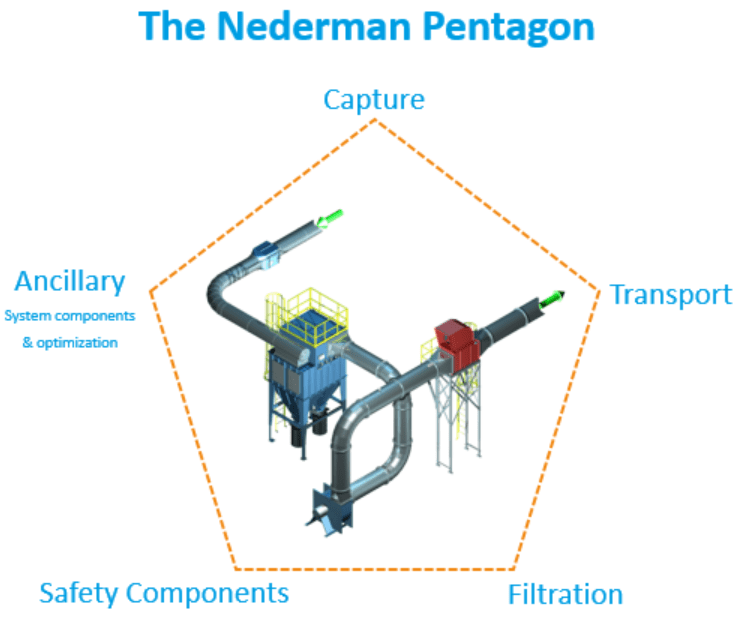
Effective wood waste and dust management is essential throughout the wood industry, however, it doesn't need to be a daunting prospect. We explore what effective wood dust extraction systems are comprised of and how they work to make your workplace safe.
Put simply, wood dust extraction is required to protect both people, planet and production from the harmful or nuisance dusts / shavings created by woodworking, manufacturing or milling processes.
These can be within primary wood applications such as a saw mill or secondary wood applications such as kitchen unit manufacture.
Clean air is a must to ensure the safety and wellbeing of a company workforce and integrity of production quality.
Inhaling wood dust poses various health risks, affecting multiple aspects of the respiratory system. This exposure can lead to respiratory irritation, manifesting as symptoms such as coughing, wheezing, and throat irritation. Additionally, individuals may develop allergies to specific types of wood dust, with prolonged exposure triggering reactions like rhinitis, conjunctivitis, and skin rashes.
The connection between wood dust and asthma has been established, contributing to bronchial constriction and respiratory difficulties. Furthermore, wood dust can cause nasal congestion, sinusitis, and inflammation, resulting in symptoms like headaches and facial pain.
Direct skin contact with wood dust can cause dermatitis, characterised by redness, itching, and skin irritation.
Certain types of wood dust, including those from hardwoods like oak, beech, and mahogany, have been classified as potential human carcinogens, with long-term exposure increasing the risk of developing nasal cancer. Wood dust may also harbour fungi and bacteria, posing an infection risk, especially in individuals with compromised immune systems.
Prolonged exposure to high concentrations of wood dust, particularly in occupational settings, has long been associated with the development of chronic respiratory conditions, including Chronic Obstructive Pulmonary Disease (COPD).
Additionally, wood dust particles can irritate the eyes, leading to symptoms such as redness, itching, and discomfort.
Wood dust presents a significant fire hazard, particularly in industrial settings where woodworking processes generate substantial amounts of dust. This combustible material, when accumulated in sufficient quantities, can serve as a potential fuel for fires and explosions. Several key considerations highlight the associated fire hazards:
Wood dust is inherently combustible and can easily ignite when exposed to an ignition source like a spark or hot surface.
In environments with a high concentration of airborne wood dust, there is a risk of creating an explosive atmosphere.
Common sources of ignition include electrical equipment, hot surfaces, welding operations, and activities that generate sparks or heat.
The accumulation of wood dust on surfaces and in confined spaces increases the likelihood of a fire. Dust layers can act as fuel, facilitating the rapid spread of flames.
Wood dust extraction systems, in fact extraction systems in general, can be categorised by the following two groups:
High Extract Volume, Low Pressure (HVLP) & Low Extract Volume, High Pressure (LVHP) – each of these types of system, although designed to perform the same protective function, go about their business in completely different ways, each operating using opposing principles while offering unique points of benefit & value that must be correctly matched via consultation to the customer's application.
An example of High Volume, Low Pressure system found in a primary wood application would be a typical NFSZ3000 ATEX approved baghouse dust collector installation, this type of system would generally be configured to capture dust at source via automated direct machine connections or articulated / localised capture points to be conveyed within appropriately dimensioned smooth bore, sealed QF ductwork at a specifically designed airflow velocity – in this type of installation larger volumes of air are required at relatively low pressure, paired with intelligent control systems, such as Nederman SAVE, these can be highly efficient options.
An example of Low Volume, High Pressure system found in a secondary wood application would be a typical ATEX approved ‘on tool’, Flex filter DX high vacuum installation, in this type of system much lower air volumes are required but at much higher operating pressures (-12KPA to -45KPA), capture would again be at source but this time due to the skilled tradesman led operation this will be by way of direct hand tool connections with automatic vacuum valves, this ensures instant extraction where it is needed – the additional added benefit of this system is the option to use as a centralised clean up vacuum system across the production facility, offering the ability to eliminate the need to blow down or brush up.
Each of these types of systems are always configured & installed with the latest in ATEX / legislative compliant ancillaries and are available with intelligent insight control technology.
For your peace of mind, every system supplied, designed and installed is done so in compliance with the latest HSE guidance & COSHH regulations.

This is the method by which the dusts or shavings created during the production process are extracted, types shall always differ system to system and a robust and thorough consolation process a must – examples can be, direct connection, on tool connection or articulated arm – it is imperative to achieve efficient capture using the most appropriate method and correct capture velocities whilst not interfering with production itself.
This element makes reference to both the air movement device (Fan set or VAC plant) and the specially dimensioned ductwork / pipe work that conveys the collected material to the dust collection matrix – correct design of this pipework system along with appropriate transport / conveyance airflow velocities are critical.
Within an ATEX rated dust extraction system aside from the primary components, equally important are the components that will ensure the safe operation of the system – via thorough consultation & partnership with the client, each dust extraction system designed to handle potentially combustible dust such as wood dust must ensure the appropriate risk mitigation measures are in place – common control components include, explosion relief panels, flameless venting devices and isolation or barrier valves.
The heart of every dust extraction system is the dust collector itself, what looks like a simple and unassuming metal box at the back of a factory, is in fact a specially selected and configured piece of engineering designed to interface correctly with the application at hand, filter the extracted air appropriately and to perform reliably and robustly year after year – If you look after your dust collector and the market leading filtration media within, in turn it will look after your people and your production.
Every Nederman dust collector cleaning system boasts the best in efficient cleaning technology, but which is right for you? Shaker / Reverse Pulse Jet / Regeneration? Along with the perfect fit collector and perfect fit system, our teams will help you reach the right conclusion.
Hand in hand with the specially configured dust collector is the correct method of safely discharging the material ejected by the dust collector cleaning system, there are many ways to do this, integral duct collection bin, twin feed out valve or even rotary valve, which is right for you will depend on your dust loads and your application.
As with most technology, rates of development and intelligence are swift and impressive, these days, your dust collection system is no different, Whether it is a need for automatic dampers that interface with CNC units or a full and complete condition monitoring system - Nederman Insight offers customers a host of digital solutions tailored in much the same way as our systems themselves
Woodworking, involving everything from small hand tools to large CNCs, whether cutting, sanding, planing, edge banding, dowel drilling, etc. can create large amounts of wood dust. To handle these various applications safely and efficiently, Nederman has developed a wide range of products and systems including small localised to large central dust collectors, piping/ducting, fans, conveyors and automated control systems. These systems make it possible for customers to not only achieve a good working environment, but also recycle wood waste, which can represents a large economic value.
Our wood dust extraction solutions are used in various woodworking settings to reduce the impact on people, planet and production from various wood-working processes and contributes to improved production economics and reduced environmental impact of industrial processes.
Nederman woodworking solutions address the following applications:
Should you wish to learn more about Nedermans wood dust extraction solutions, contact us to speak to one of our clean air specialists.
We have extensive experience of various challenges in the different industries and our experts are very skilled, helpful and professional. With us, you can feel secure that we take care of you and your needs. You are always welcome to contact us regardless if you have a short question or a more complex and complicated one. A warm welcome to Nederman.
Contact us here